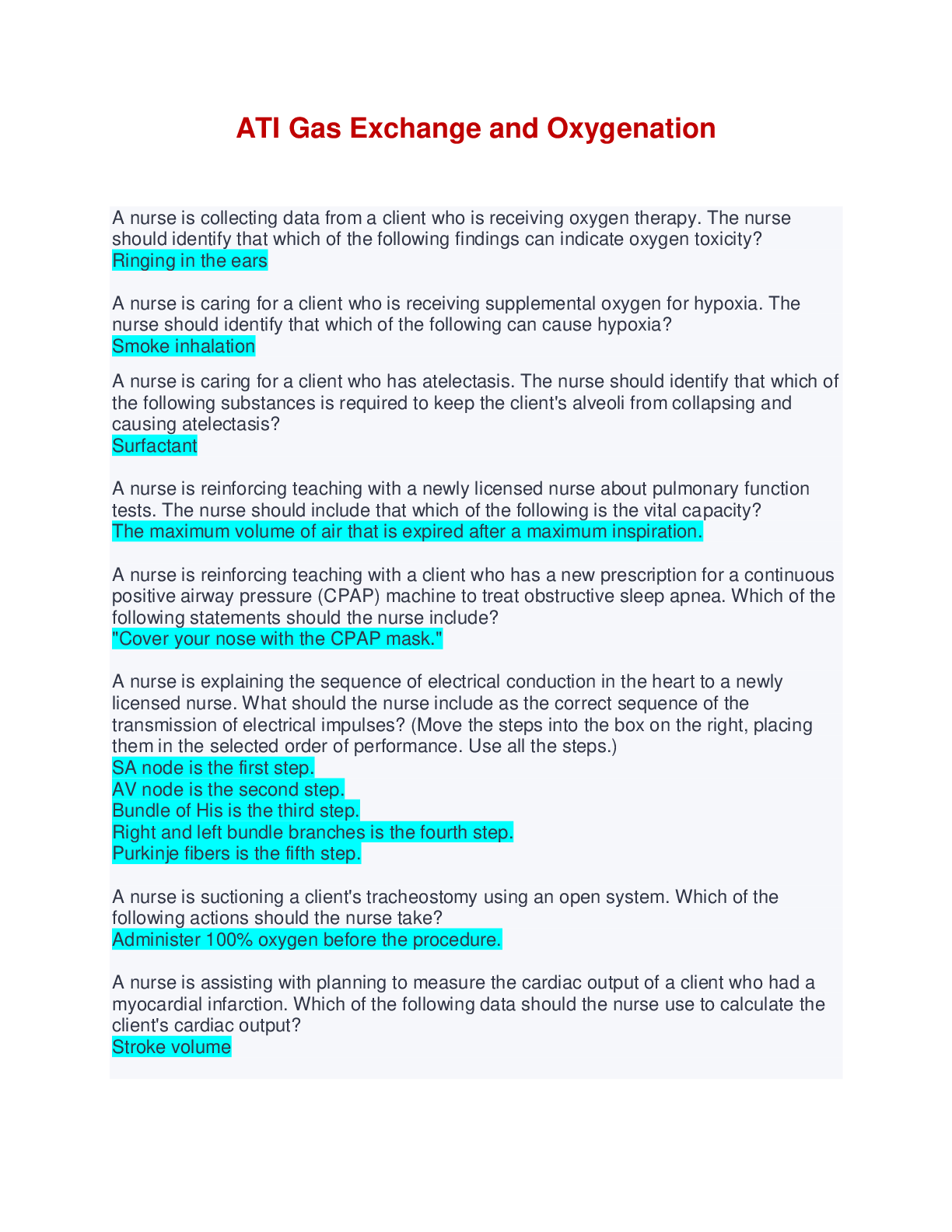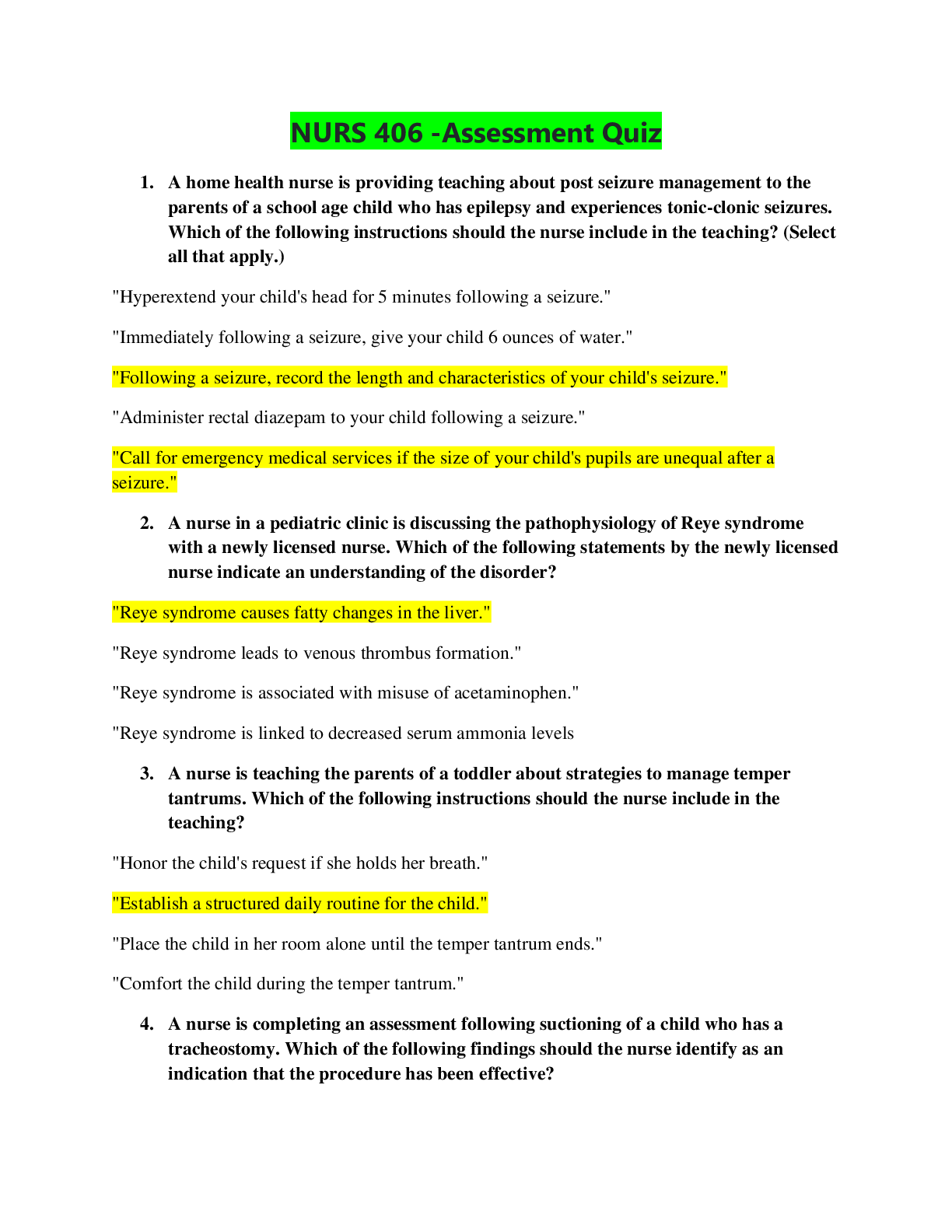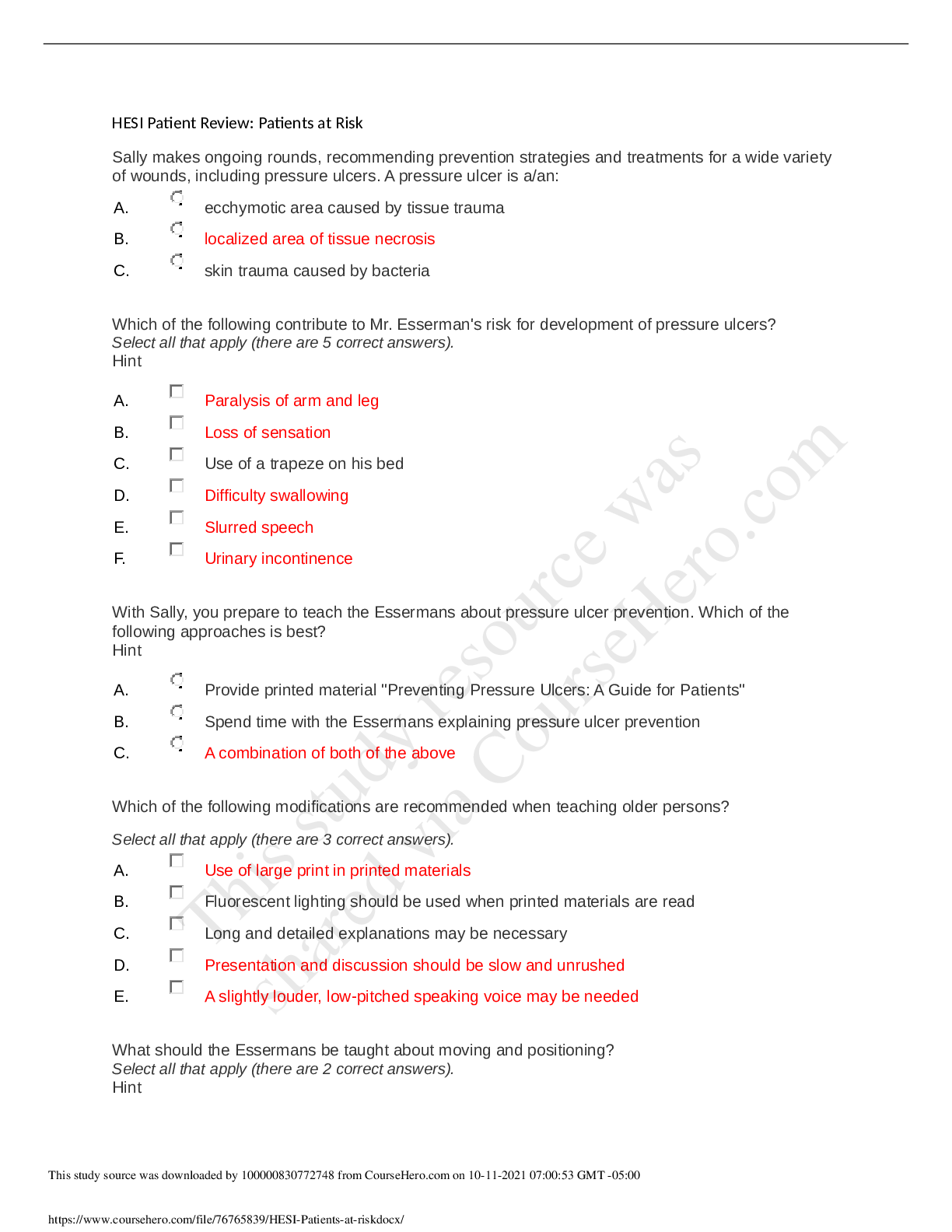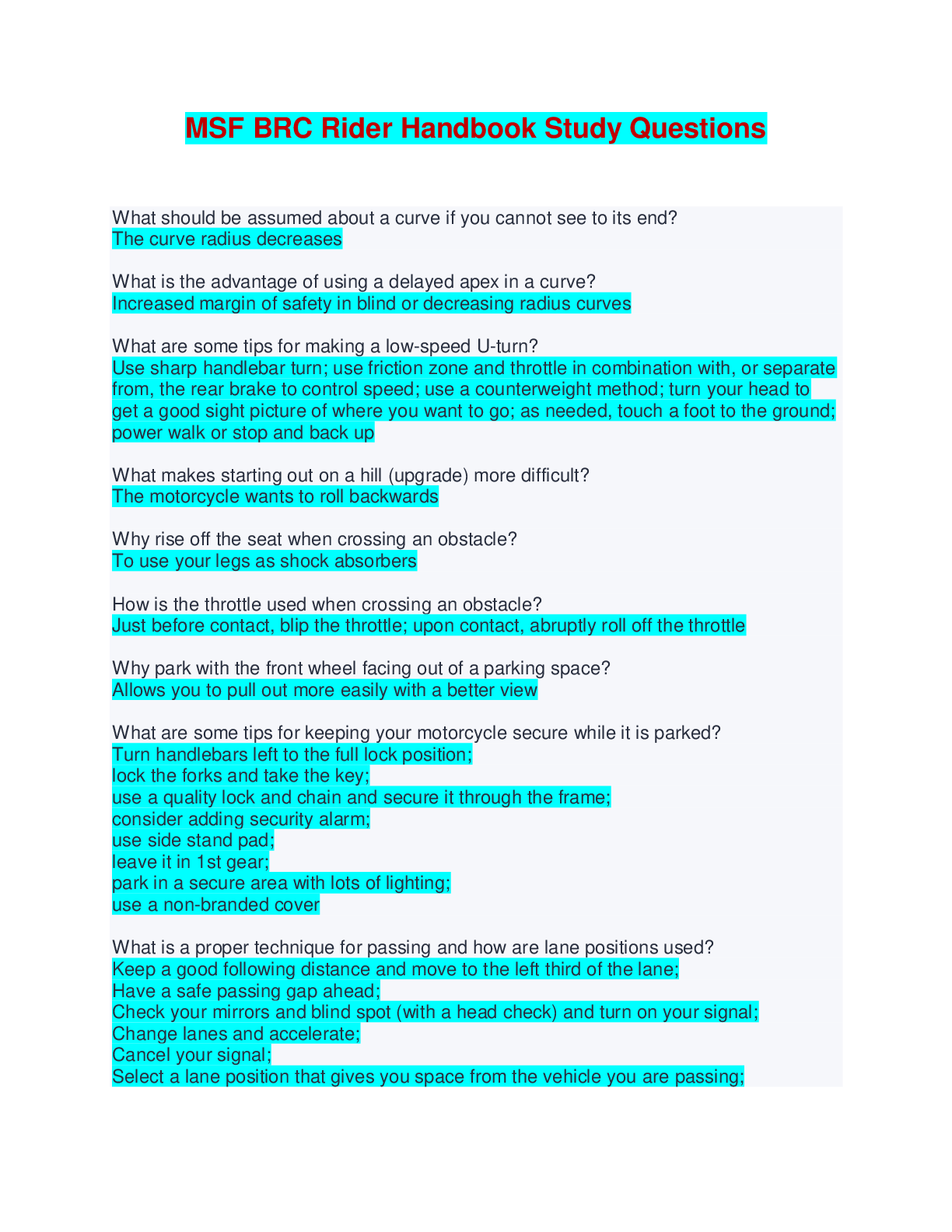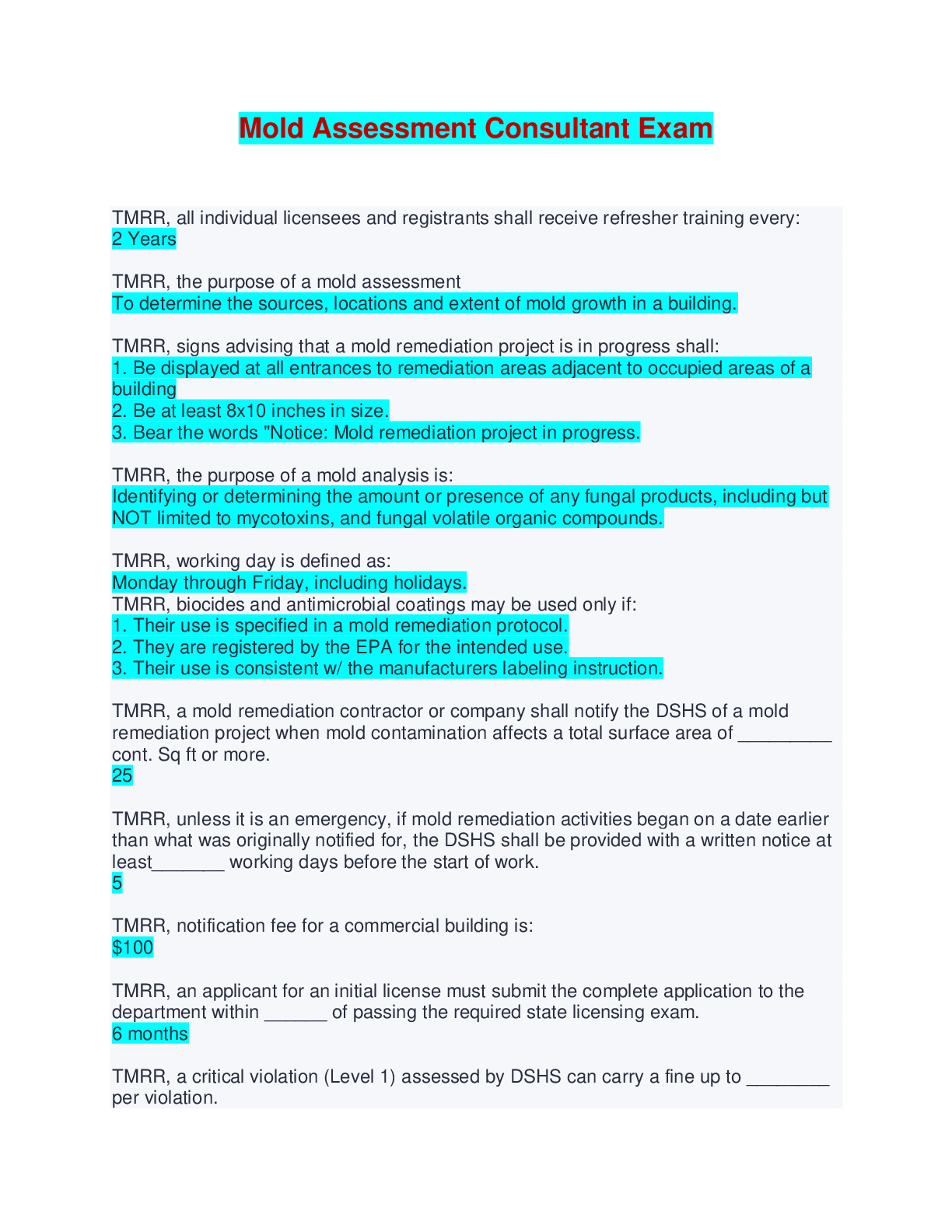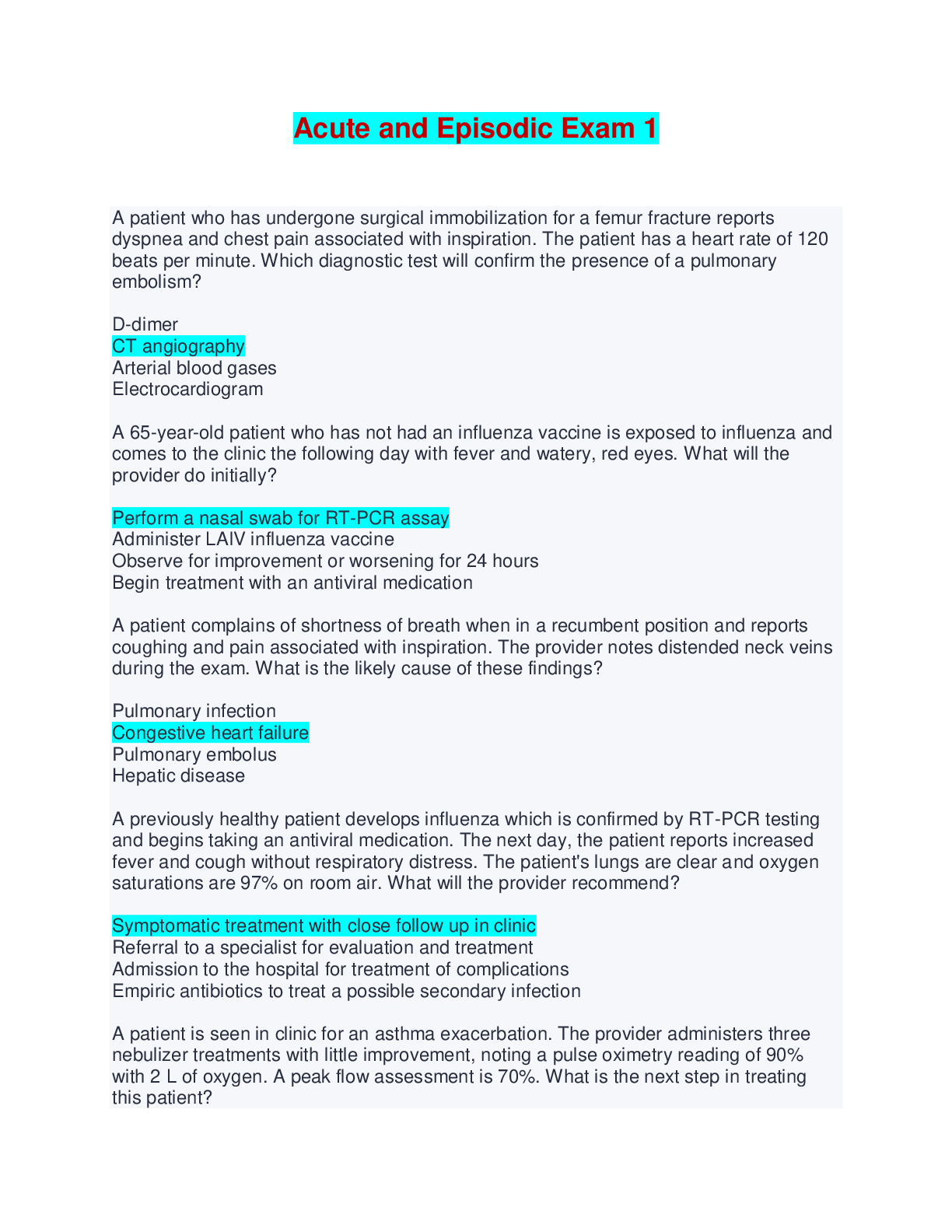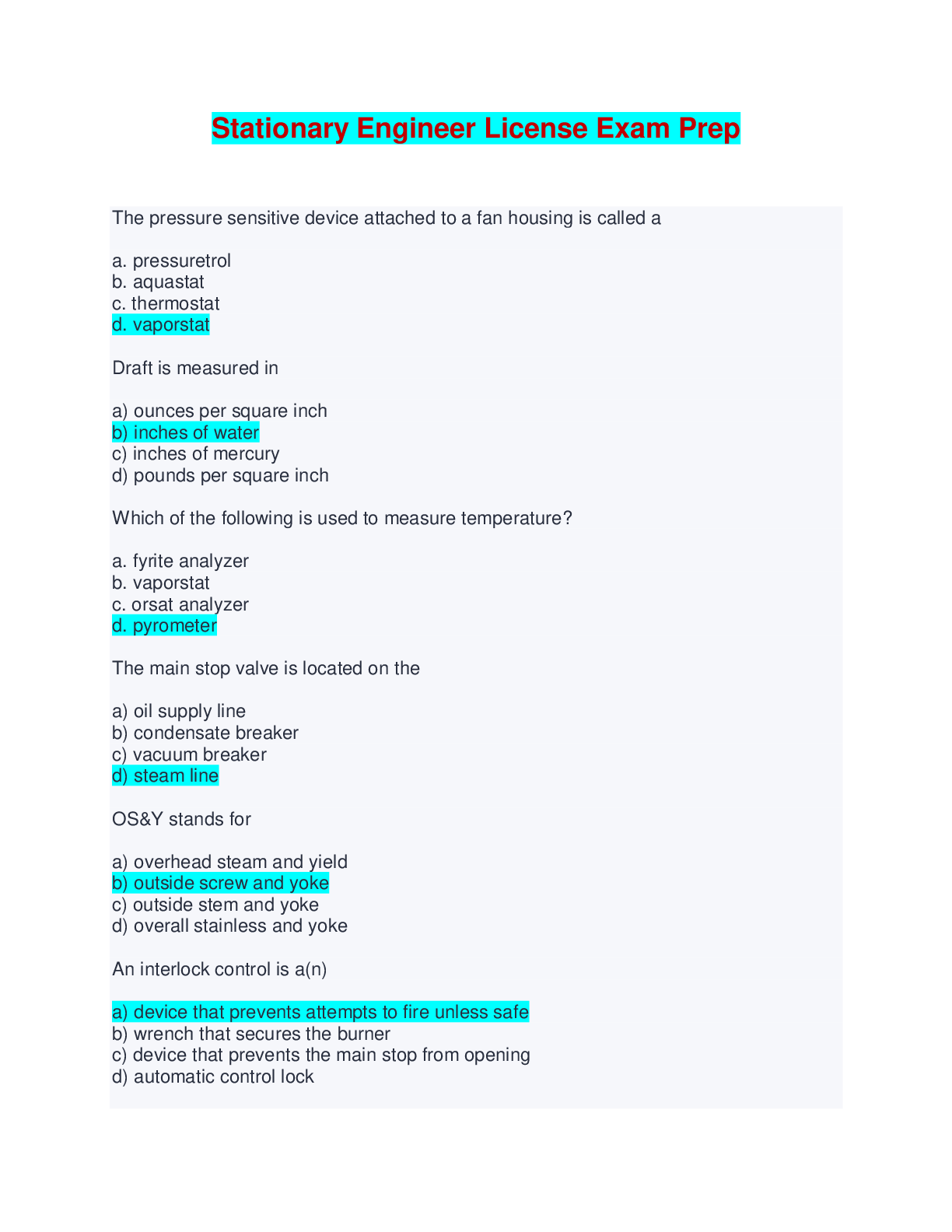Health Care > EXAM > QME Exam Prep Self-Test - Complete Solutions (Answered) (All)
QME Exam Prep Self-Test - Complete Solutions (Answered)
Document Content and Description Below
QME Exam Prep Self-Test - Complete Solutions (Answered) Opinions/conclusions must be made with reasons constituting: A. Medical Probability B. Medical Possibility C. Medical Certainty An IW having h... ad 3 similar jobs at 3 different employers, but realized she had a problem/injury of a cumulative nature while working for the most recent employer would place liability for any resultant disability/ impairment on: A. The most recent employer with WC insurance B. The employer where the problem/injury first began C. Liability for disability/impairment shared based upon apportionment D. A & B Secondary erectile dysfunction, sleep disorders and/or psych disorders that are a compensable consequence of the primary injury for 1.1.13 injuries and forward are: A. Ratable with regard to disability/ impairment B. Treatable under the claim but not ratable with regard to disability/impairment C. Only secondary/compensable psych problems are ratable D. Ratable if catastrophic in nature E. B & D Which of the following specialties/disciplines are prohibited from writing a medical legal report in a case where impairment/disability is being disputed: A. Psychology/Psychiatry B. Chiropractic C. Acupuncture - Can complete the entire report except the impairment rating D. Dentistry When a QME receives a request to schedule an evaluation, the QME must issue a QME Appointment Notification Form to all parties within: A. 60 working days B. 30 working days C. 10 working days D. 5 working days A QME report is due how many days after the completion of the face-to-face evaluation: A. 45 calendar days B. 30 calendar days C. 60 calendar days D. Only after all records have been reviewed A supplemental QME report (no face-to-face evaluation) is due how many days after the QME receives the request to do the report: A. 20 calendar days B. 30 calendar days C. 45 calendar days D. 60 calendar days When an IW had jobs involving similar work or body mechanics in 1985, 1991, 1998, and 2002 but did not realize she was having a problem requiring treatment and/or causing her impairment/disability until 2002, what would the Date Of Injury be: A. 1985 B. 1991 C. 2001 D. 2002 In the above question #8, may an employer prior to the Date of Injury be liable for any confirmed disability. A. Yes B. No If immediate/emergency treatment is required because of a serious or life-threatening situation, the provider's treatment must still meet the requirement of being consistent with the MTUS and approved before treatment is rendered. A. Yes B. No If the evaluator determines that the IW's pain increases the burden of the IW's ADLs even slightly, the evaluator may add-on to the IW's impairment how much for pain. A. 0% B. 1%-3% whole person impairment C. No more than 50% of the impairment value already determined D. Up to 3% only if the pain is headache pain If an IW has stand-alone headache pain with no other impairment for any other body part or system, the evaluator can do which of the following with regard to an impairment rating: A. No impairment can be given for stand-alone headache pain B. Headache pain can only be rated in the presence of another ratable body part or body system impairment C. A and B D. Headache pain can be given an impairment rating of between 1% to 3% 'Ex Parte' communication is legally forbidden, unless involving routine matters such as confirming appointments or that records have been sent, etc. The QME or AME should not talk to the attorneys or the carrier. A. True B. False In cases made Permanent & Stationary prior to 01/01/05, the PD (permanent disability) rating is based upon: A. Impairment rating B. Causation C. Subjective factors of disability, objective factors and work restrictions/preclusions D. A & B If an IW's right knee was injured in 2002 and the case was settled with a Stipulated Award and a PD rating of 10% and the IW re-injured the same knee again in 2007 with a PD rating of 20%, which of the following applies with regard to apportionment A. If the IW self-rehabilitated after the 2002 injury and had no complaints and was able to do his job without any problems until the 2007 injury occurred, there should be no apportionment. B. Because the 2002 injury was given a PD rating before 2005 and the 2007 same knee was injured after the AMA Guide impairment rating system was established, there should be no apportionment. C. Because the causation for the 2002 right knee injury was different from the causation of the 2007 injury, no apportionment would apply. D. Apportionment applies because it is presumed that a prior PD for the same body part is permanent and still exists. In a psyche injury claim, if the QME believes that the IW would be at risk by sending the IW a copy of the QME report with opinions and conclusions about the IW's mental & behavioral status and with regard to mental health records reviewed, the QME should do which of the following? A. Complete a QME 120 Alternative Service form designating another doctor to receive the report and to explain its contents to the IW B. Insist that the IW must retain an attorney, who can then share the report with the IW C. C. Complete a QME Form 121 to protect the disclosure of mental health records D. A & C An employee on vacation was asked by his supervisor to take one of the company's clients out to dinner. While doing so, the employee fell and broke her leg. Given this situation, which of the following would best characterize the nature of causation in this case A. COE - The injury occurred during the course of employment B. AOE - The injury arose from employment but did not occur during the course of employment C. AOE/COE - The injury arose from employment and occurred during the course of employment D. There was no industrial causation because the employee was on vacation An employee was injured in a motor vehicle accident while leaving his job in his car to go home. In this situation causation would be properly interpreted as follows: A. AOE (arose from employment) but not COE (during the course of employment B. COE because this was a daily activity in the normal course of employment C. There was no industrial causation because a normal commute to and from work is not considered to be AOE or COE D. AOE & COE Cases involving work acquired HIV/AIDS involve confidentiality for the IW that involves: A. Normal medical confidentiality laws B. The mandatory use of the QME 121 Form for protection of records C. The maintenance of a fictitious name file maintained by a WCJ D. A & C A QME or AME must address all disputed issues in a claim with the exception of: A. Medical treatment disputes are now done by an IMR B. Causation disputes C. Apportionment disputes D. Impairment rating disputes Which of the following can a QME or AME not do with regard to the IW being evaluated? A. Request reasonable & necessary diagnostic testing B. Recommend treatment C. Provide treatment on that day, unless it is a medical emergency D. Ask questions regarding the health status of family members In a situation where a QME has referred the IW out for imaging diagnostics to a radiology group in which the QME's brother-in-law is a partner, which of the following applies? A. The QME is not required to disclose a financial conflict of interest because if it does not involve an immediate family member B. The QME must only disclose a financial conflict of interest if he/she receives direct income from the facility referred to C. The QME is not required to make any disclosures unless a complaint is filed by a party to the case D. The QME must disclose the relationship on a financial conflict of interest form with the AD before proceeding with the referral A QME must retain QME reports for how many years? A. 5 B. 7 C. 10 D. For as long as the QME maintains his/her QME status A QME's evaluating a simple and routine low back sprain/strain for 5 minutes that had resolved with no need for further treatment, no need for an impairment rating, there was no apportionment indicated, no need for future medical care and no need to provide a report was objected to because of which of the following reasons A. A resolved injury with no impairment cannot be the basis for an admissible report B. The QME spent less than 20 minutes face-to-face time evaluating the IW with no explanation and did not provide a report C. Apportionment must be at issue for a report to meet the standard of evidence D. Because the employer/insurance carrier determined that there was no industrial causation Apportionment can only be based on which of the following? A. Causation of the permanent disability B. Causation of the injury C. Causation of the need for work limitations/restrictions D. Pre-existing pathology, irrespective of impairment/disability Which of the following is not a routine Activity of Daily Living, per the AMA Guide to the Evaluation of Permanent Impairment (5th Ed.) A. Sleep B. Travel C. Ability to work D. Sexual function If impairment for a given condition is not listed in the AMA Guide (5th Ed.), the evaluator may use an impairment value for a listed condition that more accurately characterizes the IW's impairment, as long as it: A. Is contained within a chapter of the AMA Guide 5th Edition B. Is validated by scientifically and peered reviewed research C. Is an impairment that does not exceed 50% D. Is in ACOEM or MTUS A low back injury to a sedentary, light work individual such as a secretary may not substantially infringe upon the secretary's ability to work, but the same injury in a heavy construction worker might be a career ending injury. Therefore, under SB899, the best way to measure impairment is based upon: A. Work capacity B. Pre-injury capacity C. The routine Activities of Daily Living which everyone must do irrespective of their job D. Future medical care needs An injured worker who routinely lifted over 50 pounds repetitively throughout the work day was injured and can now, while being treated and recovering, only lift 20 pounds or less and this injured worker is now being accommodated with light work in a sedentary job. This situation would be classified as: A. Partial permanent disability B. Temporary permanent disability C. A reasonable accommodation D. Permanent disability Temporary disability benefits/payments from 2005 forward can last for: A. 25 weeks B. 100 weeks C. 104 weeks D. 150 weeks When an IW contacts a QME to make an appointment, the QME must set the appointment within how many days of the contact? A. 4 weeks B. 60 days C. 120 days D. 10 days In a case involving an unrepresented injured worker with a DOI after 2005 where there is a dispute with the employer/insurance carrier, the following can be selected for evaluation to resolve the dispute: A. AME B. Each party can select its own QME C. The injured worker can only rely upon the opinion of the PTP D. Panel QME A QME who uses an assisting nurse to take and record vital signs, a historian to review records and interpret them for the QME, and a clerical worker who transcribes the QME's report has done which of the following: A. Violated medical confidentiality B. Violated under penalty of perjury that the QME reviewed the records; even if the QME uses a historian, the QME needs to also review their work and the records and name them in the report as assisting in the production of the report C. Followed acceptable and legal protocols D. Failed to perform all aspects of the consultation, examination, and report generation without the assistance of others An Information & Assistance Officer can talk to a represented IW, an unrepresented IW and anyone else. A. True B. False When rating a case made permanent & stationary before 2005, which of the following are used to determine the disability rating? A. Subjective factors of disability (intensity & frequency of pain) B. Objective factors of disability C. Work preclusions/restrictions D. All of the above When measuring extremity joint ranges of motion (ROM) in cases made permanent & stationary prior to 2005, which standard normal values are used? A. AMA Guide to the Evaluation of Permanent Impairment (5th Ed.) B. There are no accepted 'normal' ROM values C. The un-injured extremity ROM is considered to be the 'normal' ROM value D. Packard Thurber's 'Estimated Average Normals' 1960 Which of the following are considered to be objective findings? A. Patient complaints which are consistent with examination findings B. Lab tests, electrodiagnostic testing, x-rays and other imaging C. Grip strength testing with less than expected effort D. Examination findings that is consistent with the findings of other doctors Can an IW being evaluated by a QME or AME tape record the consultation and examination? A. Yes B. No An IW treating within an approved MPN who does not like or agree with the treating doctor's opinion and treatment plan can do which of the following? A. Seek an opinion from only one other MPN doctor B. Seek an opinion from up to two other doctors within the MPN C. May transfer to the doctor of the IW's choice outside of the MPN D. Must have a hearing at the WCAB to change treating doctors If an IW is cut on the job, treated on the job with first aid and then sees a doctor for follow up, who returns the IW to work without any restrictions or limitations, the incident should be: A. Filed as a workers' compensation claim B. Reported within 5 days to the DWC-Medical Unit C. Handled only within the employer's/insurance carrier's approved MPN D. Considered a minor first aid incident with no claim filed An IW who had fractured her fibula in a fall on steps at work was provided with appropriate treatment and rehabilitation, eventually being returned to work with no job-limiting preclusions/restrictions. When finally evaluated, it was determined that her routine ADLs were not affected, and there were no positive examination findings but the evaluating QME gave her a 3% rating for pain. Which of the following would be true? A. Residual pain/discomfort, irrespective of the ADLs, can be given between a 1%-3% WPI rating B. An impairment rating for pain is only valid if the IW is reasonably required to take pain medication C. No impairment rating should have been given for pain with a 0% rating D. Fibula fracture, irrespective of treatment outcome, carries an automatic impairment rating for reasonably anticipated post-surgical pain involvement When evaluating an injured extremity in a 2010 case, the evaluator must do which of the following? A. Compare findings to normal values in the AMA Guide (5th Ed.) B. Compare findings to Packard Thurber's 'Estimate Average Normals' C. Compare findings to the opposite, un-injured extremity D. Report only findings relevant to the injured extremity When evaluating an IW with impairment to three separate body parts, (e.g., elbow, low back, and knee), how should the impairment values for each body party be handled to establish an overall combined whole body impairment rating? A. The values for each body part should be combined using the Combined Values Chart (Page 604) in the AMA Guide (5th Ed.) starting with the highest value (Yes, per the AMA Guides - but not the state of CA, which wants you to bring each body part to a whole person impairment rating and leave it alone) B. The values for each body part should be added together C. The values for each body part should be listed separately and not added or combined D. The values should only be combined if the different body part impairments were caused by the same injury An IW who is being accommodated by their employer with modified work duty should receive temporary disability compensation only if the following is true: A. Only if the modified work pays less than 85% of the IW's salary/earnings that were being paid at the time of the injury B. Only if the IW is a medically eligible qualified injured worker C. Only if the IW has been given a final impairment or disability rating D. Only if the modified work pays less than 90% of the IW's salary/earnings that were being paid at the time of the injury If a licensed doctor is not a QME but both parties in a represented case, (both attorneys), agree to use the doctor as an AME to perform a medical-legal evaluation to resolve a disputed issue, it is legally permissible. A. True B. False If a person reviews the records for a QME for purposes of organizing and consolidating the records, it is considered: A. A violation of LC4638 and CCR10606 B. Permissible only if the historian provides his/her opinions and conclusions regarding the records reviewed C. Legal if the historian's charge does not exceed $100 per hour D. Permissible if the activity is described in the QME's report and is identified in the report - The QME can only charge for the time that they have spent with the records If a QME contacts the PTP to gather more information, ask questions or inquire about records, it is considered to be: A. An illegal 'ex parte' communication under SB899 in a case with a DOI before 2005 B. Legal and does not constitute 'ex parte' communication, but the contact and nature of the information/records obtained should be described in the QMEs report C. An illegal 'ex parte' communication under SB863 in a case with a DOI after 2004 D. Grounds for immediate dismissal of the QME from the case Can an IW request to see the QME's curriculum vitae, license or QME certificate at the time of the face-to-face evaluation? A. Yes B. No If a QME's report is late, (i.e., served more than 30 days after the evaluation), which of the following parties has the right to object to the QME's report? A. Only parties in a represented case B. Only an unrepresented injured worker C. Only the insurance carrier's claims adjustor D. All of the above If a QME has previously treated the IW scheduled to be evaluated, under which circumstances can the QME proceed to evaluate the IW without a conflict of interest? A. Only if deemed permissible by a WCAB judge B. Only if both parties in a represented case agree to allow it C. Never D. Always When a QME completes a report in an unrepresented case where the IW is found to be permanent & stationary and has been given a final impairment rating, where should the report be sent besides providing copies to the IW and to the insurance carrier? A. DWC-Medical Unit B. WCAB C. Information & Assistance Office D. DEU In an unrepresented case, if the DEU has not issued a summary rating determination, where should a QME's supplemental report be sent to? A. Only to the parties to the case B. A supplemental report should not be issued until a determination is made C. Only to the WCAB D. Only to the DWC-Medical Unit [Show More]
Last updated: 3 weeks ago
Preview 1 out of 46 pages
Instant download

Loading document previews ...
Buy this document to get the full access instantly
Instant Download Access after purchase
Add to cartInstant download
Reviews( 0 )
Document information
Connected school, study & course
About the document
Uploaded On
Jun 06, 2024
Number of pages
46
Written in
Additional information
This document has been written for:
Uploaded
Jun 06, 2024
Downloads
0
Views
12


